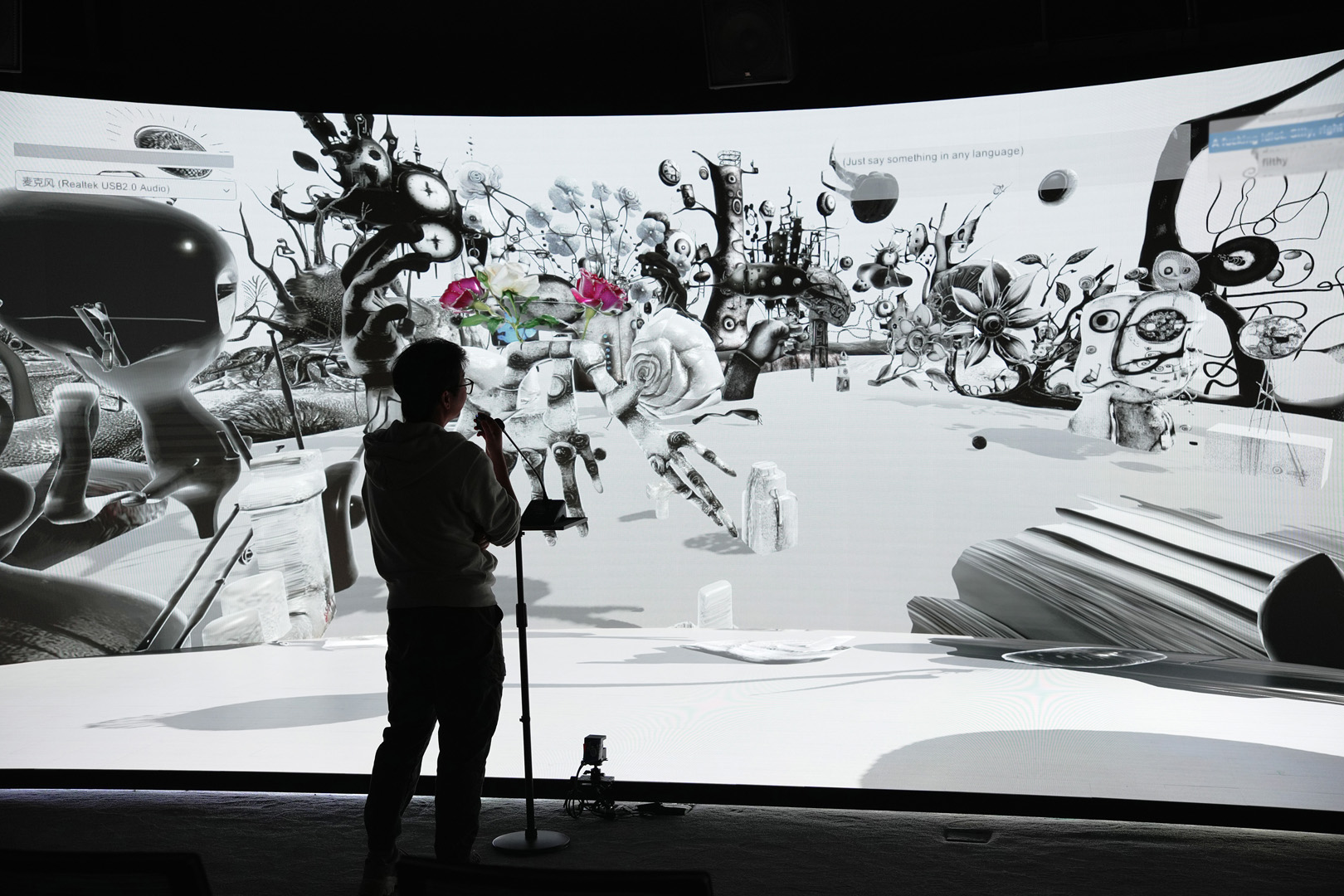“Ephemera: Language as a Virus — AI-driven Interactive and Immersive Art Installation” by Guljajeva, Yip, Huang and Huang
Conference:
Type(s):
Title:
- Ephemera: Language as a Virus — AI-driven Interactive and Immersive Art Installation
Session/Category Title: Script & Prescribe
Presenter(s)/Author(s):
Abstract:
In this paper, we introduce the speech-based interactive and immersive installation, Ephemera, as an artistic response to the linguistic taboos encountered in daily communication, prompting audience reflection and thoughts. Within this project, we symbolize the dissemination chain of language through a computational ecosystem. Utilizing the surreal ‘virus’ as an embodiment of banned words, we employ generative models for visual representation, leverage large language models for communicative agents, and use machine learning for behavioral engines, ultimately simulating a digitally autonomous micro-organism world of forbidden language. We contextualized the speech-to-content generation process to draw the audience’s attention to the power and constraints of language. Additionally, we examine AI’s comprehension of censored words and ethical considerations. Finally, our artistic project proposes the aphorism “Language as a virus, art as an antibody,” offering novel perspectives on language taboos and art-technology intersections.
References:
[1]
Jaffar Abbas, Dake Wang, Zhaohui Su, and Arash Ziapour. 2021. The role of social media in the advent of COVID-19 pandemic: crisis management, mental health challenges and implications. Risk management and healthcare policy (2021), 1917–1932.
Google Scholar
[2]
Keith Allan and Kate Burridge. 2006. Forbidden words: Taboo and the censoring of language. Cambridge University Press.
Google Scholar
[3]
Linda Candy and Ernest Edmonds. 2018. Practice-based research in the creative arts: Foundations and futures from the front line. Leonardo 51, 1 (2018), 63–69.
Crossref
Google Scholar
[4]
Mar Canet Sola and Varvara Guljajeva. 2022. Dream Painter: Exploring creative possibilities of AI-aided speech-to-image synthesis in the interactive art context. Proceedings of the ACM on Computer Graphics and Interactive Techniques 5, 4 (2022), 1–11.
Digital Library
Google Scholar
[5]
Ian Cheng. 2019. BOB. Retrieved April 4, 2024 from https://bobs.ai/
Google Scholar
[6]
Ferdinand de Saussure. 2011. Course in general linguistics. Columbia University Press.
Digital Library
Google Scholar
[7]
Marta Dynel. 2023. Lessons in linguistics with ChatGPT: Metapragmatics, metacommunication, metadiscourse and metalanguage in human-AI interactions. Language & Communication 93 (2023), 107–124.
Crossref
Google Scholar
[8]
Sigmund Freud. 2012. Totem and taboo. Routledge.
Google Scholar
[9]
Chunming Gao. 2013. A sociolinguistic study of English taboo language. Theory and Practice in Language Studies 3, 12 (2013), 2310.
Crossref
Google Scholar
[10]
David Glukhov, Ilia Shumailov, Yarin Gal, Nicolas Papernot, and Vardan Papyan. 2023. LLM Censorship: The Problem and its Limitations. (2023).
Google Scholar
[11]
Google. 2024. Google AI Principles. Retrieved April 4, 2024 from https://ai.google/responsibility/principles/
Google Scholar
[12]
Cari Beth Head, Paul Jasper, Matthew McConnachie, Linda Raftree, and Grace Higdon. 2023. Large language model applications for evaluation: Opportunities and ethical implications. New Directions for Evaluation 2023, 178-179 (2023), 33–46.
Crossref
Google Scholar
[13]
Hyunkyung Ji and Graham Wakefield. 2011. Time of Doubles. In SIGGRAPH Asia 2011 Art Gallery. 1–1.
Google Scholar
[14]
Arthur Juliani, Vincent-Pierre Berges, Ervin Teng, Andrew Cohen, Jonathan Harper, Chris Elion, Chris Goy, Yuan Gao, Hunter Henry, Marwan Mattar, and Danny Lange. 2020. Unity: A general platform for intelligent agents. arXiv preprint arXiv:1809.02627 (2020). https://arxiv.org/pdf/1809.02627.pdf
Google Scholar
[15]
Neil Mendoza. 2019. Robotic voice-activated word-kicking machine. In ACM SIGGRAPH 2019 Art Gallery. 1–2.
Digital Library
Google Scholar
[16]
Laurent Mignonneau and Christa Sommerer. 2001. Creating artificial life for interactive art and entertainment. Leonardo 34, 4 (2001), 303–307.
Crossref
Google Scholar
[17]
Benjamin Péret. 2021. THE INN OF THE FLYING ARSE. Retrieved April 4, 2024 from https://www.surrealism-plays.com/inn-of-the-flying-arse.html
Google Scholar
[18]
Winnie Soon. 2023. Unerasable Characters Series. Retrieved April 2, 2024 from https://calls.ars.electronica.art/2023/prix/winners/7149/
Google Scholar
[19]
Sarah Wasserman. 2020. The Death of Things: Ephemera and the American Novel. U of Minnesota Press.
Google Scholar
[20]
Wikipedia. 2024. Former Ode on the Red Cliffs. https://en.wikipedia.org/w/index.php?title=Former_Ode_on_the_Red_Cliffs
Google Scholar





